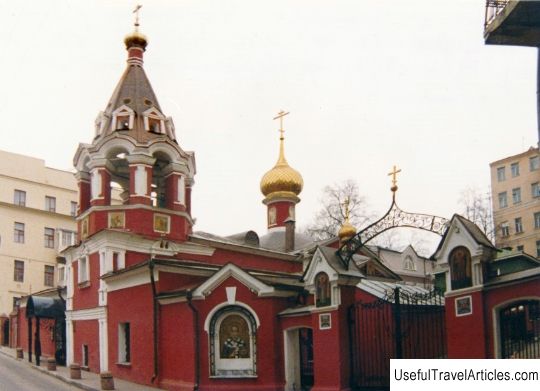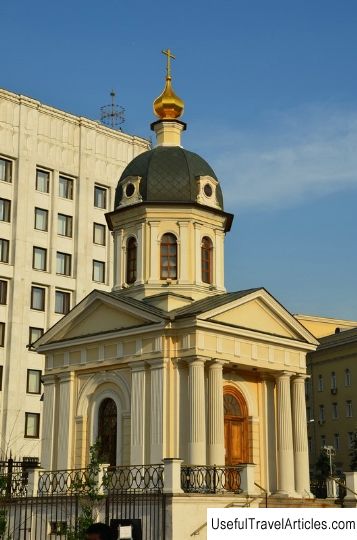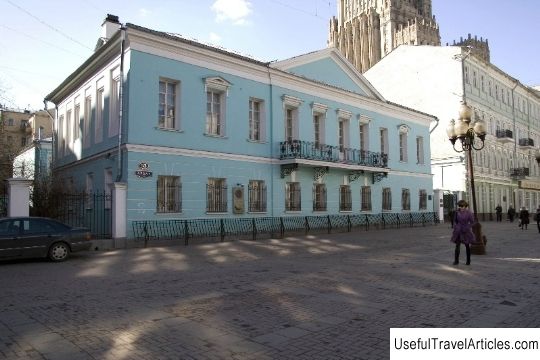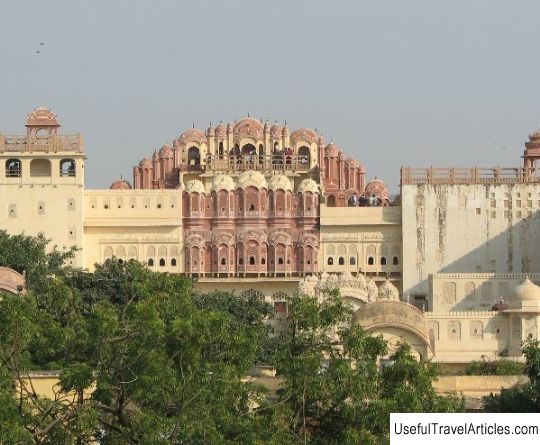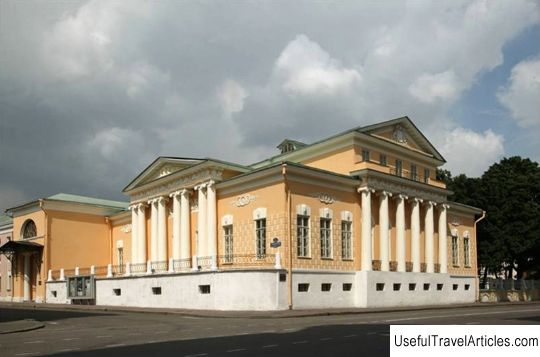Arbat description and photo - Russia - Moscow: Moscow
Rating: 8,2/10 (1240 votes) 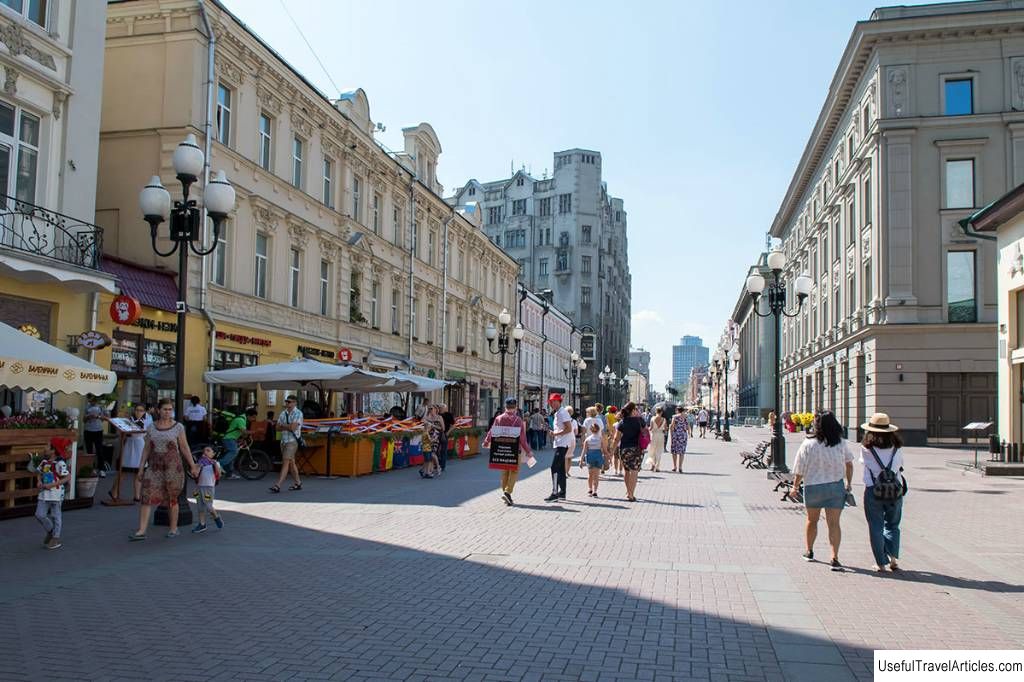
Arbat description and photo - Russia - Moscow: Moscow. Detailed information about the attraction. Description, photographs and a map showing the nearest significant objects. The name in English is Arbat. Photo and descriptionEven those who have never been to the capital know about Moscow's Arbat Street . A street in the center of Moscow has long become one of the main city attractions. Poems and songs are written about the Arbat, guests from the provinces rush here to take a photo for memory and buy souvenirs and gifts for friends, and Arbat artists offer passers-by their paintings, which depict Moscow streets and architectural monuments. Arbat begins at Arbatskiye Vorota Square , stretches for 1.2 km and ends at Smolenskaya Square . History of ArbatTo establish where the toponym "Orbat" came from, the researchers of the history of Moscow did not succeed, but in the XVI-XVII centuries the area around Vozdvizhenka was called that. stretching from modern Znamenka to Bolshaya Nikitskaya street. The most plausible version seems to be that the name Orbat, and later - Arbat, came from the word "arba". In the old days on Volkhonka there was a Kolymazhnaya settlement, the inhabitants of which made carts and carts, among which there were also carts. There is also an alternative opinion that "arbat" is a derivative of the word "humpback", because the area in this part of old Moscow looked like a crooked line on the city plan. Even earlier, the place where the Arbat Gate Square is located today, called We'll be able to . In the XV-XVI centuries it was not inhabited and adjoined the Moscow suburbs. The road to Smolensk and Mozhaisk began from Vspol'e. Urban development in the area of modern Arbat began to form at the end of the 15th century. The Grand Duke Ivan III undertook reconstruction, as a result of which palaces were located on the outskirts and outskirts of settlements where artisans lived. Arbat was first mentioned in documents and chronicles in 1565, when Ivan the Terrible ordered the founding of the first streltsy settlement in this part of Moscow and established an oprichnina inheritance there. In the 17th century, Konyushennaya and Plotnitskaya settlements were opened on the streets adjacent to today's Arbat. At the same time, rifle regiments were quartered on the Arbat. During its existence, one of the most famous streets in Moscow has experienced many significant and interesting events. Arbat was renamed, his churches were dismantled and closed, and the street itself burned to the ground in the Moscow fires. By the end of the 18th century, Arbat had turned into an aristocratic district and Moscow nobility began to buy houses here. The families of the Dolgoruky and Gagarin, Sheremetev and Kropotkin families were in the Empire style mansions, and N.V. Gogol and A. S. Pushkin, A. P. Chekhov and A. Blok, L. N. Tolstoy and M. E. Saltykov-Shchedrin. In Arbat lanes Vasily Polenov painted pictures, Sergei Yesenin recited poetry and Sergei Rachmaninov composed music. New era The revolution brought a lot of new things to the whole country and the Arbat, and its image began to change rapidly already in the 20s of the last century. When designing new houses, the aesthetics of constructivism prevailed, and the architects themselves sought to unify the buildings, painting the facades in a single neutral color. Aristocratic mansions were given over to communal housing. It was required by new Muscovites who came to build a bright future from all over the country. During the war, Arbat was repeatedly subjected to air strikes, but immediately after Victory Street restored one of the first. In 1952, a skyscraper appeared on Smolenskaya Square, where the Arbat ended, and in the 70s it was decided to make the street completely pedestrian . By that time, the main traffic flows were redirected to Kalinin Avenue, often called Novy Arbat. The project was ready by 1978. It included not only a ban on the movement of vehicles, but also many types of works for the improvement of public space and the reconstruction of buildings. Specially made paving stones were laid by 1986, retro-lanterns and benches were installed along the street. Interesting buildings and structures on the Arbat Most of the houses that have survived on the Arbat to this day are of considerable architectural and historical value. While taking a tour of the famous Moscow street, pay attention to the mansions and monuments: - In the 20s of the last century in house N9, page 1 there was a popular bohemian cafe “Arbatsky basement ". Yesenin with Isadora Duncan, Mayakovsky and Lilya Brik, Blok and Pasternak often became its visitors. Before the revolution, the house housed the editorial office of the Sverchok magazine. - On the facade of house N11 , the attention of walkers is invariably attracted by the masks of lions made by a sculptor in the Renaissance style. The apartment building of the Moscow Private Lombard Joint Stock Company before the revolution was famous for issuing loans secured by jewelry, and in Soviet times - for the Bukinist store. - The Haunted House they name the building that appeared on the Arbat after the fire of 1812 on the site of the old mansion of General Chambers. This house N14 appears in the stories of Gilyarovsky, although the ghosts that frightened the neighbors then turned out to be beggars and vagabonds who arbitrarily settled in the basement. - In 1906, on the second floor of the mansion N15 / 43 The Bolshoi Parisian Theater was opened, which became the founder of the first chain of cinemas in the capital. - Echkin's hotel and apartment building appeared on the Arbat in the early 19th century. In the 70s of the same century, the brother of the famous Russian traveler N.M. Przhevalsky became its owner. At the beginning of the twentieth century house N23 was rebuilt by the famous architect N. Lazarev, and today the mansion is called one of the most beautiful on the Arbat. Its facade is decorated with Art Nouveau elements and tiled with small ceramic tiles. Famous Moscow shops were located on the first floor before the revolution. The building is also notable for the fact that in the attic it first housed the studio of the sculptor Konenkov, and then the artist Korin, whose guest was often Maxim Gorky. - “House with Knights”, located at: Arbat, 35/5 , was built at the beginning of the twentieth century by the architect Dubrovsky. The building was intended for wealthy tenants and looked like a skyscraper against the background of other mansions. The interiors were finished with oak panels, stained-glass windows and marble, the apartments had several rooms, and the corridors were decorated with huge mirrors. On the main facade of the house you can see sculptures of knights. - Tsoi's Wall is called fans of the "Kino" group facing the wall of house N37 in Krivoarbatsky lane, built in the 18th century for Count Bobrinsky. The facade decoration of the mansion has remained unchanged since 1834. In the 20-30s of the XIX century, the house was owned by the grandson of Catherine II and Count Orlov. - Bulat Okudzhava spent his childhood in a communal apartment on the 4th floor of building N43 on Arbat, and before the revolution, the office supplies store "Nadezhda", located in this house, was mentioned in his poems by Andrey Bely. - The monument to Okudzhava is installed opposite one of the entrances of house N47 / 23 . This place used to be famous for its ice cream stand. Inside it, the air temperature was kept low all year round, and the sellers did not take off their sheepskin coats even in summer. - The hero of A. Rybakov's novel "Children of the Arbat" was house N51 , where the writer lived in 1919 -1933 years. In 1920, A. Blok stayed in the house, who came to the capital to visit the literary critic and historian P. Kogan. - In the house with the Smolensky grocery store on Arbat, one of the scenes from Bulgakov's novel The Master and Margarita took place. In real life, a Torgsin store was opened in house N50-52 , where goods were sold for foreign currency. After the abolition of this trade organization, the grocery store received serial number 2 and became the second after Eliseevsky. In 1831 in house N53, page 1 after the wedding brought his young wife A. Pushkin. The poet and Natalya Nikolaevna lived on the Arbat for only three months, but the history of the house was also made by its other residents. Over the years, the artist S. Akimova and the brother of P. Tchaikovsky, relatives of S. Rachmaninov and Marina Tsvetaeva stayed and lived in it. Now the building houses a museum called "Pushkin's Memorial Apartment on Arbat". Several monuments and memorial plaques installed on Arbat Street are also worthy of tourist attention. The sculpture "Alexander Pushkin and Natalia Goncharova", cast from bronze and installed in 1999, was created by the Burganov sculptors, and the monument to Okudzhava by the sculptor G.V. Frangulyan. In memory of those who died during the Stalinist repressions, memorial signs with the names of residents who were shot in the dungeons of the NKVD appeared on the facades of houses NN30 and 51. The memory of the famous residents of houses NN 45 and 51 M. Shaginyan, I. D. Papanin and A. N. Rybakov is also immortalized with memorial signs. Restaurant "Prague" The famous Moscow restaurant "Prague" appeared on the Arbat in 1872, when a tavern for cab drivers was opened in VI Firsanova's apartment building . A quarter of a century later, the inn owner lost it to the merchant Tararykin at billiards. An enterprising merchant did not miss the opportunity to earn money and turned a medium-sized establishment into a luxury restaurant. At the beginning of the twentieth century, the building was rebuilt several times, and in 1914 even a winter garden was arranged on the roof. The revolutionary mood also affected Prague, and in 1924 the restaurant was redesigned into the Mosselprom canteen, and a few months later it was a library was completely opened in one of the premises of the catering establishment. The canteen was liquidated in the 1930s, and Prague was reopened only in 1954 after a major reconstruction. The renovated restaurant quickly became one of the best in the capital, and to get here you either had to stand in line or have connections and acquaintances. A lot of interesting facts and events are connected with "Prague": - The premiere of "The Seagull", which took place in 1898, was celebrated in "Prague". The author of the play, A.P. Chekhov, was present at the banquet on the occasion of the performance along with the actors of the Moscow Art Theater. - In 1913, after the painting Repin spoiled by a fanatic “Ivan the Terrible kills his son ", Was restored, the artist held a banquet in" Prague ". - Mayakovsky's poem dedicated his poem to the restaurant, which was Mosselprom's dining room in the 1920s . - The hero of the novel Ilf and Petrov "Twelve Chairs" Vorobyaninov took Lisa to the dining room in "Prague". By the way, the famous Bird's Milk cake , which in Soviet times was desirable decoration of any festive table, in the 70s of the last century invented by the confectioners of "Prague".         We also recommend reading National Park ”Gargano” (Parco nazionale del Gargano) description and photos - Italy: Apulia Topic: Arbat description and photo - Russia - Moscow: Moscow. |

